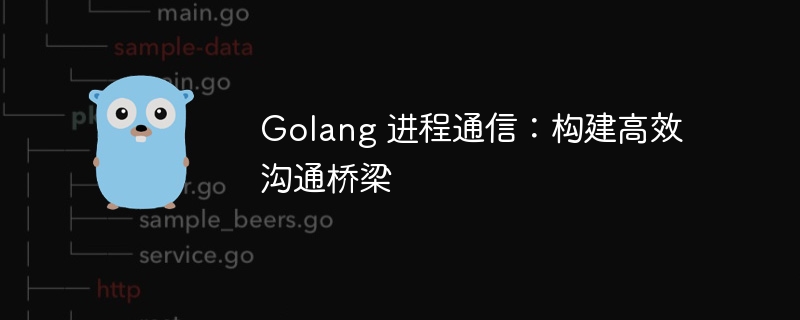Home >Backend Development >Golang >Golang process communication: building an efficient communication bridge
Golang process communication: building an efficient communication bridge
- 王林Original
- 2024-04-03 22:09:02990browse
Inter-process communication (IPC) in Go is implemented through pipes, channels and shared memory. Pipes allow coroutines to write and read data through pipe endpoints, while channels guarantee the atomicity of send and receive operations. Shared memory enables fast data exchange by allowing processes to access the same memory, but requires synchronization to prevent concurrent access.

Go Process Communication: Building an Efficient Communication Bridge
Implementing inter-process communication (IPC) in Go is crucial because it enables concurrent applications to Share information and coordinate operations securely and efficiently. This article aims to explore the basic concepts and practices of IPC in Go and solidify understanding with practical examples.
Types of inter-process communication
In Go, there are several IPC mechanisms to choose from:
- Pipes: Allows one process to write data to one endpoint while another process reads from another endpoint.
- Channels: Similar to pipes, but only supports communication between related processes.
- Shared memory: Allows processes to access the same memory, allowing for fast data exchange.
Using pipes for IPC
Pipes are the simplest IPC mechanism in Go. It allows one goroutine to write data to the pipe and another goroutine to read data from it. The following code example demonstrates how to use pipes for IPC:
package main
import (
"fmt"
"time"
)
func main() {
// 创建一个管道
myPipe := make(chan int)
// 启动一个 goroutine 向管道写入数据
go func() {
for i := 0; i < 5; i++ {
myPipe <- i
time.Sleep(100 * time.Millisecond)
}
}()
// 从管道读取数据
for i := 0; i < 5; i++ {
fmt.Println(<-myPipe)
}
}Using channels for IPC
Channels are similar to pipes, but they are more secure because it guarantees the atomicity of send and receive operations. The following code example demonstrates how to use channels for IPC:
package main
import (
"fmt"
"time"
)
func main() {
// 创建一个通道
myChannel := make(chan int)
// 启动一个 goroutine 向通道写入数据
go func() {
for i := 0; i < 5; i++ {
myChannel <- i
time.Sleep(100 * time.Millisecond)
}
}()
// 从通道读取数据
for i := 0; i < 5; i++ {
fmt.Println(<-myChannel)
}
}Using shared memory for IPC
Shared memory allows processes to access the same block of memory. This is a very fast form of IPC, but requires careful synchronization to avoid concurrent access. The following code example demonstrates how to use shared memory for IPC:
package main
import (
"fmt"
"sync"
"runtime"
)
func main() {
// 分配共享内存
var sharedMem [10]int
// 创建一个互斥锁用于同步
var lock sync.Mutex
// 启动一个 goroutine 向共享内存写入数据
go func() {
for i := 0; i < len(sharedMem); i++ {
lock.Lock()
sharedMem[i] = i * i
lock.Unlock()
runtime.Gosched()
}
}()
// 从共享内存读取数据
for i := 0; i < len(sharedMem); i++ {
lock.Lock()
fmt.Println(sharedMem[i])
lock.Unlock()
runtime.Gosched()
}
}Conclusion
Inter-process communication is an important aspect of concurrent programming in Go. By using IPC mechanisms such as pipes, channels, and shared memory, applications can share information and coordinate operations efficiently and securely. This article explores the basic concepts and practices of IPC in Go and solidifies understanding with practical examples.
The above is the detailed content of Golang process communication: building an efficient communication bridge. For more information, please follow other related articles on the PHP Chinese website!

